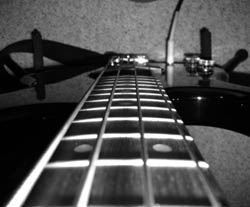Bass doesn’t always get the attention it deserves in a recording situation. I see a lot of recordists rush through bass recording, only to later be frustrated with the bass when it comes time for mixing. It’s really too bad because it’s the foundation of the song.
A great bass will groove tight with the drums and support the guitars. Fitting it in the mix will take minimal effort and you will be loving life.
A great recording starts with a great source. When it comes to tracking bass guitar, the source is comprised of many factors.
Musician:
—Technique and playing position – Playing with a pick or with fingers or thumb. Intensity, Playing close to the bridge, in the middle or close to the neck. Choose what is appropriate for the song.
—What is played – Playing bass lines that serve the song and don’t clash with the drums or guitars rhythmically or melodically.
—Tuning – Check the tuning often.
Bass:
—Strings – New strings usually sound best and give you the brightest tone to start with.
—Electronics (Pickups and EQ) – The pickup selection and tone settings.
—Wood and construction – The wood used in the neck and body really effect the sound. Maple and Ash are bright and punchy, mahogany is thicker and darker.
Amplification chain:
—Cable – Debatable how much impact this has, how about just using one that doesn’t hum or crackle if you move it.
—Pedals – If a particular pedal helps get you the desired tone, go for it. I would hold off on spatial effects (delay, reverb) until mixing as they require their own attention.
—Amplifier and EQ settings – Tube or solid state. As a starting point put all EQ knobs at 6.
—Cabinet – 1×12-inch, 4×10-inch, 1×15-inch.
—Cabinet position – Where in the room, close to walls, on the floor or elevated.
Everything contributes to the sound you’ll be recording, do whatever you can to get this close to what you need from the start. It won’t be the same for every song so you may want to have a few options for basses, though a Fender Jazz bass or MusicMan is versatile enough to get you what you need 80 percent of the time. Rent or borrow what you don’t own before looking for magical plugins to solve all your bass problems.
In my experience getting good bass gear for recording made my life so much easier further along in my projects. For recording you don’t necessarily need a massive bass rig, I use a Sterling Ray 34 (Low-end Music Man. Swamp ash body, maple neck, humbucker pickup with active EQ) into a small Ampeg BX112 solid state combo amp with a single 12-inch woofer. Greatest bass recording gear ever? Ha—far from it, but it got me so much closer to the sound I was looking for.
Prior to that I was fighting with a mahogany bass that was deep but had almost no midrange when recorded making it hard to hear clearly in the mix.





















